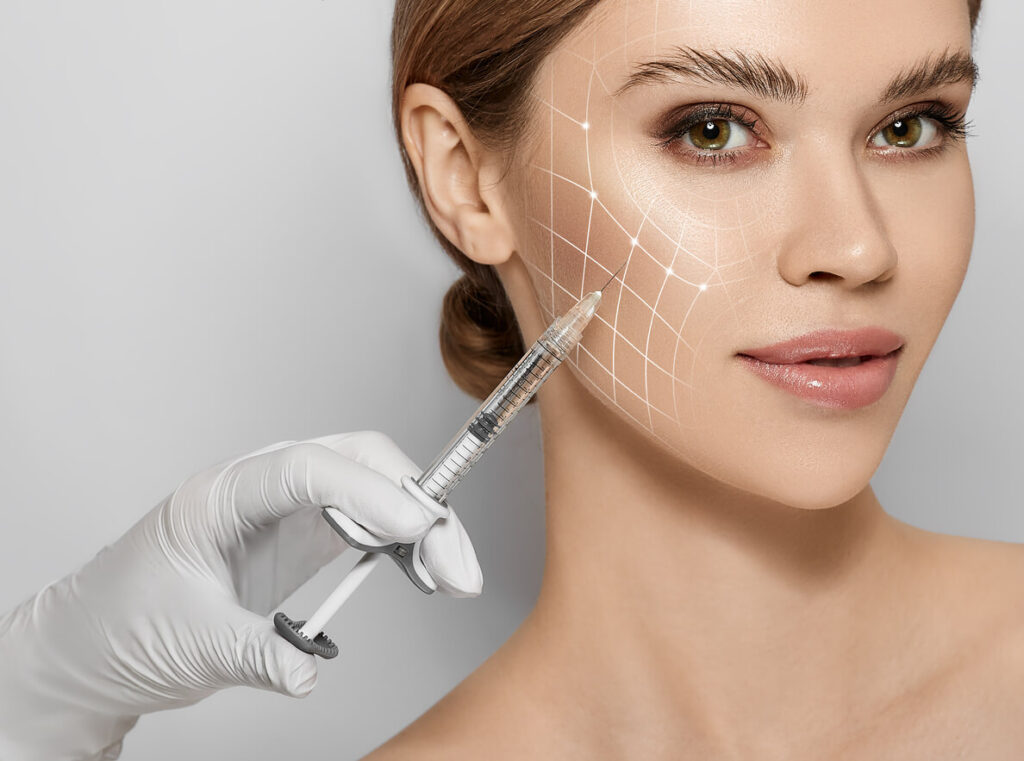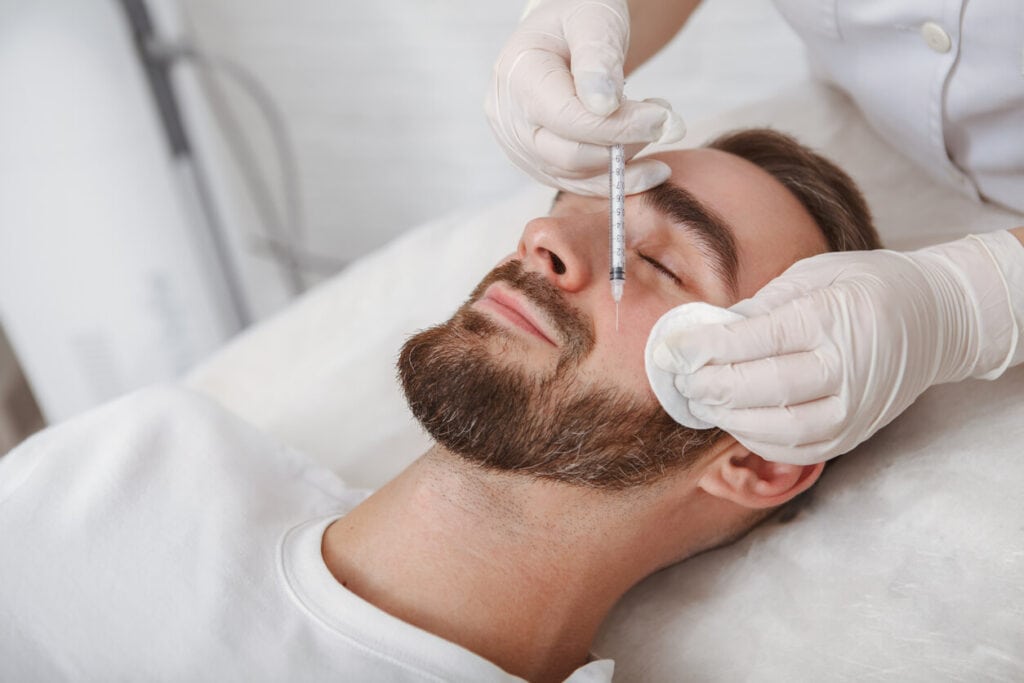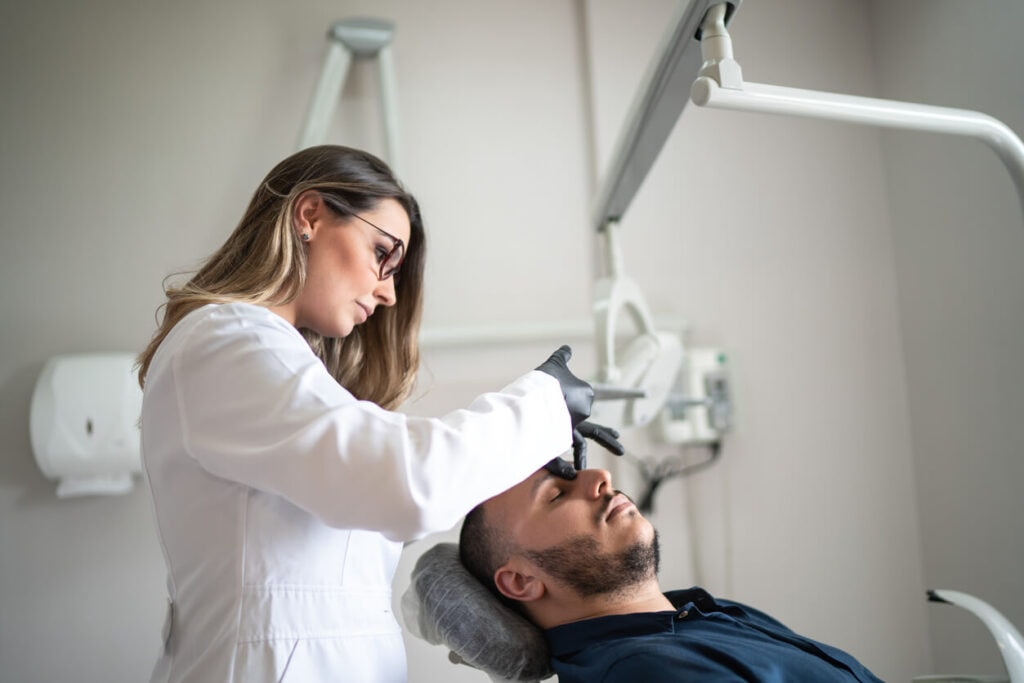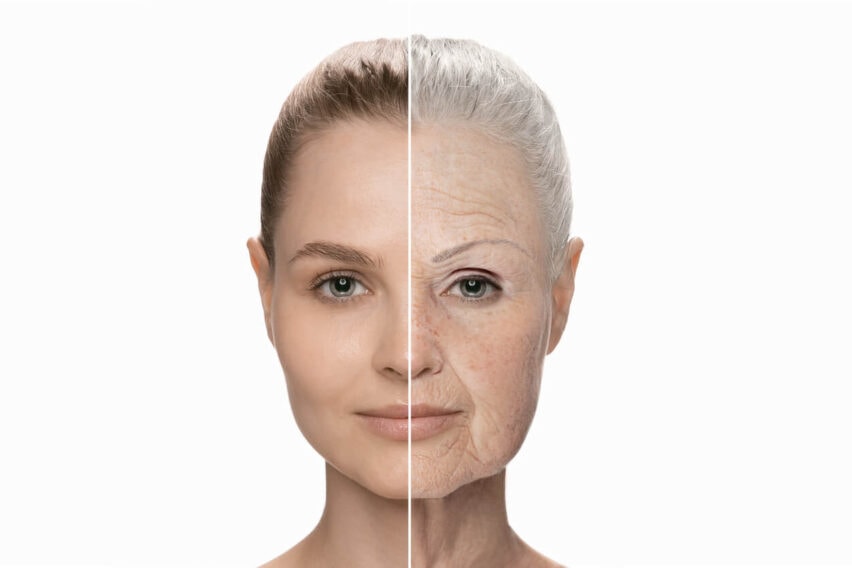Our skin inevitably succumbs to the natural ageing process as we age, resulting in fine lines, wrinkles, and volume loss.
This has fuelled an ever-growing concern among individuals striving to maintain their vibrancy and confidence.
Thanks to scientific progress, we now have cosmetic tricks up our sleeves to help turn back the clock.
One such trick is the use of dermal fillers. These injectables have gained significant popularity recently due to their effectiveness and minimally invasive nature.
Like any medical procedure, it pays to have all the information before you get the injections. So, here is everything you need to know about dermal fillers.
What Are Dermal Fillers?
Dermal or soft tissue fillers are non-surgical cosmetic treatments designed to rejuvenate and enhance facial features. They are injectable substances that restore volume, smooth out wrinkles, and address signs of ageing, yielding a more youthful and refreshed appearance.
What to Expect When Getting a Dermal Filler
The procedure entails a quick injection with a fine needle that provides volume with an immediate “plumping” effect on the treated area. A lip treatment, for instance, can take approximately 15 minutes to administer. Your Registered Nurse will be available to check on you and address any questions you may have following your treatment.
How Long Dermal Fillers Last?
The effects of dermal fillers can last anywhere from six to eighteen months depending on:
- The type of dermal filler used
- The treated area
- Your metabolism
- Your aftercare routine
We recommend you schedule treatments twice yearly to achieve and sustain your desired outcomes.

What Are the Different Types of Dermal Fillers?
Dermal fillers are often categorised based on their composition and longevity. Some of the main types of dermal fillers include Hyaluronic Acid (HA), Calcium Hydroxylapatite fillers, Poly-L-Lactic Acid fillers, and Polymethyl Methacrylate (PMMA) fillers.
At Face Clinic London, we use the latest generation of Dermal Fillers, including Juvederm® by Allergan and Restylane® by Galderma, both world leaders in aesthetic products. These are typically clear injectables made from hyaluronic acid injected into the skin.
Hyaluronic acid (HA) is a naturally occurring substance found in the human body, particularly in the skin, connective tissues, and eyes. HA’s remarkable ability to retain moisture makes it essential for maintaining skin hydration and suppleness.
As part of the ageing process, the body’s production of hyaluronic acid diminishes, contributing to the loss of volume and the development of wrinkles. When injected beneath the skin’s surface, hyaluronic acid-based dermal fillers act as volumisers, plumping up areas of the face that have lost elasticity and fullness over time.
What Are the Key Advantages of Hyaluronic Acid Fillers?
Among the various dermal fillers available, those containing hyaluronic acid are the most popular. These fillers offer the following key advantages that contribute to their widespread use:
- Natural-Looking Results: Hyaluronic acid is naturally found in the human body. This makes HA fillers well-tolerated and compatible with the body’s tissues, producing more natural results. The ability to mimic the body’s natural structure helps achieve subtle enhancements without an overly artificial appearance.
- Reversibility and Adjustability: Unlike other dermal fillers, which are permanent or semi-permanent, HA fillers can be reversed or adjusted if needed. If a patient is dissatisfied with the results or wants to make changes, an enzyme called hyaluronidase can be used to break down the HA filler and restore its original appearance.
- Versatility and Customisation: HA fillers come in various formulations with different consistencies and molecular weights. This allows practitioners to choose the most appropriate filler for specific areas of the face, tailoring the treatment to meet each patient’s unique needs.
Individual preferences and characteristics can influence the choice between different types of dermal fillers. Consult a qualified medical professional to determine the best filler option based on your needs and desired outcomes.

What Areas Can Be Treated With Dermal Fillers?
Dermal fillers offer a versatile solution for addressing various areas of the face, providing natural-looking results without the need for invasive procedures. Here are keys areas of the face that can be treated with dermal fillers:
1. Cheeks and Midface
Dermal fillers are often used to restore volume to the cheeks and midface, as ageing can lead to fat loss and a sunken appearance. Injecting fillers in these areas allows the cheeks to regain their youthful plumpness, creating a lifted and more defined contour.
2. Nasolabial Folds
Nasolabial folds (smile lines) form from the corners of the nose to the corners of the mouth. These folds become more prominent as skin loses elasticity and facial fat diminishes with age. Dermal fillers can be strategically placed along these folds to smooth them out, resulting in a softer and less tired look.
3. Marionette Lines
Similar to nasolabial folds, marionette lines develop over time, extending from the corners of the mouth down to the chin. Dermal fillers can be used to plump up this area, reducing the appearance of these lines and restoring a more youthful jawline.
4. Lips and Perioral Area
Dermal fillers can enhance the volume and shape of the lips, creating a fuller and more defined pout. They can also be applied around the mouth to address fine lines and wrinkles in the perioral region, often called “smoker’s lines.”
5. Under-Eye Hollows/Tear Troughs
The delicate skin under the eyes can show signs of ageing through hollowing and dark circles. Dermal fillers injected into the tear trough area can fill in hollows, reduce the appearance of dark circles, and create a smoother transition between the lower eyelid and cheek.
6. Jawline and Chin
Dermal fillers can help reshape and define the jawline and chin, offering a non-surgical alternative to procedures like chin implants or jawline contouring surgery. Adding volume to these areas can achieve a more balanced and youthful facial profile.
7. Temporal Hollows
Ageing can cause volume loss in the temples, leading to a sunken appearance that affects the overall facial balance. Dermal fillers can restore volume in the temporal area, rejuvenating the upper face and creating a more harmonious look.
8. Brow Lift
Strategically placed dermal fillers can create a subtle lift in the brow area, improving the appearance of sagging or drooping eyebrows. This technique can provide a refreshed and more awake look without the need for surgery.
9. Non-Surgical Rhinoplasty
For individuals seeking minor adjustments to the shape of their nose, dermal fillers can be used to camouflage bumps, enhance the nasal bridge, or refine the tip. This non-surgical rhinoplasty option avoids the downtime and risks associated with surgical procedures.
10. Acne Scarring and Facial Contouring
Dermal fillers can also be used to address acne scars, pitted skin, and irregularities on the face’s surface. By filling in these depressions, the skin’s texture can be improved. Additionally, fillers can be used for facial contouring, highlighting certain features like the chin or jawline.

What are the Side Effects of Dermal Fillers?
Just like any other treatment, dermal fillers come with potential side effects. Common reactions include temporary redness, swelling, or bruising at the injection site.
These typically subside within a few days. In rare cases, allergic reactions might occur, so discuss any allergies with your provider beforehand.
What Are the Advantages of Dermal Fillers?
Several cosmetic treatments are available to help rejuvenate and enhance the appearance of the skin. Among these options, dermal fillers have various advantages that make them popular for many individuals seeking non-surgical solutions.
5 Advantages that set dermal fillers apart from other treatments
- Non-Invasive Nature: Dermal filler treatments are minimally invasive and do not require incisions or surgical procedures. Unlike facelifts or surgical interventions, dermal fillers offer a quicker recovery time with minimal discomfort. Patients can often resume their daily activities immediately after the procedure.
- Quick Results: Patients typically notice improvements in their appearance immediately after the treatment session. This quick turnaround time makes dermal fillers an excellent option for those seeking rapid cosmetic enhancements, unlike certain treatments that require weeks or months to showcase noticeable changes.
- Customisable Approach: Dermal filler treatments offer a high degree of customisation to address individual concerns. This adaptability ensures that each patient’s unique features are considered, producing more natural results.
- Gradual Rejuvenation: Some treatments, such as surgical facelifts, can result in a sudden and dramatic transformation. Dermal fillers, on the other hand, enable a more gradual rejuvenation process. The subtle and progressive improvements allow patients to maintain their natural appearance while appearing more youthful and refreshed.
- Reduced Risk and Downtime: Compared to surgical interventions, dermal fillers carry a lower risk of complications and adverse effects. The recovery period is also generally brief, with minimal swelling or bruising.
These benefits collectively make dermal fillers attractive for individuals looking to enhance their appearance without the commitment or risks associated with more invasive procedures.

Choosing the Right Dermal Filler for You
When considering dermal fillers, select the most suitable option for your needs. Here’s a guide to help you choose the right dermal filler for you:
1. Understand Your Goals
You must clearly understand your aesthetic goals before getting a dermal filler. Are you seeking to reduce fine lines, add volume to sunken areas, or enhance certain features? Different fillers are designed to address specific concerns, so knowing your goals will help you narrow down your options.
2. Consult a Professional
Speak to a qualified medical professional, such as a dermatologist or a plastic surgeon. The expert will evaluate your unique facial anatomy, skin type, and aesthetic goals to recommend the most suitable filler.
3. Consider Longevity
Dermal fillers vary in terms of how long their effects last. Some hyaluronic acid fillers provide results that can last anywhere from six to eighteen months, while non-hyaluronic acid fillers may offer results that endure for a couple of years. Your preference for temporary or longer-lasting results will influence your choice.
4. Location Matters
Different face areas have distinct characteristics, requiring specific fillers for optimal results. For example, finer fillers are typically used for delicate areas like under the eyes, while thicker fillers may be used to enhance cheekbones. Your practitioner will help you choose the right filler for each area.
5. Budget Considerations
Dermal filler treatments can vary in cost based on the type of filler used and the extent of treatment. Discuss your budget with your medical professional to find a suitable option that aligns with your financial considerations.

Dermal Filler Post-Treatment Care and Follow-Up
After getting dermal filler injections, you need post-treatment care to ensure optimal results and minimise potential complications. Here are some key guidelines to follow:
- Minimise Swelling and Bruising: Swelling and bruising are common after dermal filler injections. Apply a cold compress to the treated area for the first 24 hours to help reduce swelling. Avoid touching or massaging the area, as this can exacerbate bruising.
- Avoid Strenuous Activities: Refrain from intense physical activities, such as heavy lifting and vigorous exercise, for the first 24-48 hours post-treatment. This helps to prevent increased blood flow to the treated area, which could lead to additional swelling.
- Stay Hydrated: Drinking plenty of water promotes overall skin health and can enhance the effects of the filler. Proper hydration can also help reduce the risk of swelling and promote faster healing.
- Sun Protection: Protect your skin from excessive sun exposure, as UV rays can negatively impact the treated area.
- Avoid Alcohol and Blood Thinners: Alcohol consumption and blood-thinning medications can increase the risk of bruising and swelling. Avoid these substances for a few days before and after treatment.
- Follow Provider Instructions: Your healthcare provider will give you specific post-treatment instructions based on the type of filler used and the treated area. Adhering to these guidelines is crucial for optimal results and safety.
- Follow-Up Appointments: Schedule any recommended follow-up appointments with your provider. These visits allow them to assess your progress, address any concerns, and make necessary adjustments.
Remember, individual experiences with dermal fillers may vary. Communicate openly with your provider about any discomfort, changes, or questions during recovery.
Get Your Dermal Filler Injections at Face Clinic London
While it would be great to look young forever, time leaves its marks on our skin.
Dermal fillers are a quick and easy to restore a youthful appearance by correcting facial wrinkles and volume loss. When performed by a trained medical practitioner, these fillers can provide several benefits without requiring extensive recovery time or invasive surgery.
Check out the rest of our website to learn about the specific areas of the face we treat at Face Clinic London.
At Face Clinic London, we specialise in bringing back your skin’s youthful radiance through expert non-surgical cosmetic treatments. Our skilled team understands that each face is unique, and we tailor our approach to enhance your natural beauty.
Contact us today to book your consultation and take the first step toward a more youthful you!
Book Appointment
All treatments are carried out by our team of doctors at our London Botox clinic. Appointments can be booked online, via email or by calling our Soho clinic on 020 7851 6624 during opening hours. We are located a few minutes walk away from Carnaby Street.
Call our clinic team if you have any questions
View our prices
Or email us
